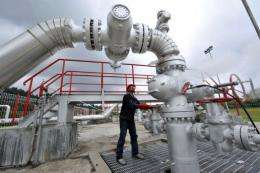Indonesia aims to tap volcano power

Indonesia has launched an ambitious plan to tap the vast power of its volcanoes and become a world leader in geothermal energy, while trimming greenhouse gas emissions.
The sprawling archipelago of 17,000 islands stretching from the Indian to the Pacific Oceans contains hundreds of volcanoes, estimated to hold around 40 percent of the world's geothermal energy potential.
But so far only a tiny fraction of that potential has been unlocked, so the government is seeking help from private investors, the World Bank and partners like Japan and the United States to exploit the power hidden deep underground.
"The government's aim to add 4,000 megawatts of geothermal capacity from the existing 1,189 megawatts by 2014 is truly challenging," Indonesian Geothermal Association chief Surya Darma said.
One of the biggest obstacles is the cost. Indonesia currently relies on dirty coal-fired power plants using locally produced coal. A geothermal plant costs about twice as much, and can take many more years in research and development to get online.
But once established, geothermal plants like the one built in Kamojang, Java, in 1982 can convert the endless free supplies of volcanic heat into electricity with much lower overheads -- and less pollution -- than coal.
This is the pay-off the government is hoping to sell at the fourth World Geothermal Congress opening Sunday on the Indonesian resort island of Bali. The six-day event will attract some 2,000 people from more than 80 countries.
"An investment of 12 billion dollars is needed to add 4,000 MW capacity," energy analyst Herman Darnel Ibrahim said, putting into context the recent announcement of 400 million dollars in financing from lenders including the World Bank and the Asian Development Bank (ADB).
"Field exploration can take from three to five years, suitability studies for funding takes a year, while building the plant itself takes three years," he added.
If there is any country in the world where geothermal makes sense it is Indonesia. Yet despite its natural advantages, it lags behind the United States and the Philippines in geothermal energy production.
Southeast Asia's largest economy and the world's third biggest greenhouse gas emitter exploits only seven geothermal fields out of more than 250 it could be developing.
The case for geothermal has become stronger with the rapid growth of Indonesia's economy and the corresponding strain on its creaking power infrastructure.
The archipelago of 234 million people is one of the fastest growing economies in the Group of 20 but currently only 65 percent of Indonesians have access to electricity.
The goal is to reach 90 percent of the population by the end of the decade, through a two-stage plan to "fast-track" the provision of an extra 10,000 MW by 2012, mostly through coal, and another 10,000 MW from clean sources like volcanoes by 2014.
President Susilo Bambang Yudhoyono's pledge to slash greenhouse gas emissions by 26 percent against 2005 levels by 2020 has also spurred the push to geothermal.
Many of the best geothermal sources lie in protected forests, so the government aims to allow the drilling of wells inside conservation areas while insisting that the power plants themselves be outside.
Geothermal fans welcomed the recent completion of negotiations between a consortium of US, Japanese and Indonesian companies and the state electricity company, Perusahaan Listrik Negara, over a 340 MW project on Sumatra island.
The Sarulla project will be Indonesia's second biggest geothermal plant, after the Wayang Windu facility in West Java.
"The Sarulla project is a perfect example of how Indonesia can realise its clean energy and energy security goals by partnering with international firms," US Ambassador Cameron Hume wrote in a local newspaper.
Several firms such as Tata and Chevron have submitted bids to build another geothermal plant in North Sumatra, with potential for 200 MW.
(c) 2010 AFP


















